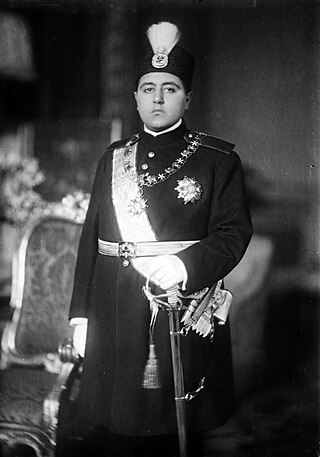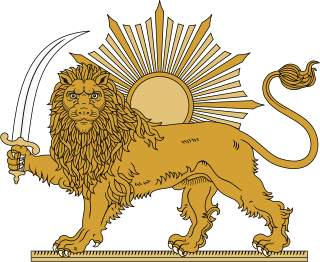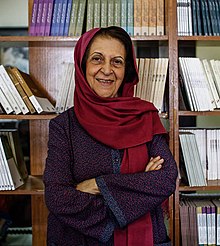The Persians are an Iranian ethnic group who comprise over half of the population of Iran. They share a common cultural system and are native speakers of the Persian language as well as of the languages that are closely related to Persian.

Reza Shah Pahlavi was an Iranian military officer and the founder of the Pahlavi dynasty. As a politician, he previously served as minister of war and prime minister of Qajar Iran and subsequently reigned as Shah of Pahlavi Iran from 1925 until he was forced to abdicate after the Anglo-Soviet invasion of Iran in 1941. He was succeeded by his eldest son, Mohammad Reza Shah. A modernizer, Reza Shah clashed with the Shia clergy and introduced many social, economic, and political reforms during his reign, ultimately laying the foundation of the modern Iranian state. As a result, he is regarded by many as the founder of modern Iran.

The Qajar dynasty was an Iranian royal dynasty founded by Mohammad Khan of the Qoyunlu clan of the Turkoman Qajar tribe.

Ahmad Shah Qajar was the Shah of Persia (Iran) from 16 July 1909 to 15 December 1925, and the last ruling member of the Qajar dynasty.

Mohammad Ali Shah Qajar was the sixth shah of the Qajar dynasty and remained the Shah of Iran from 8 January 1907 until being deposed on 16 July 1909.

Mozaffar ad-Din Shah Qajar, was the fifth Qajar shah (king) of Iran, reigning from 1896 until his death in 1907. He is often credited with the creation of the Persian Constitution of 1906, which he approved of as one of his final actions as shah.

The prime minister of Iran was a political post that had existed in Iran (Persia) during much of the 20th century. It began in 1906 during the Qajar dynasty and into the start of the Pahlavi dynasty in 1923 and into the 1979 Iranian Revolution before being abolished in 1989.
The military history of Iran has been relatively well-documented, with thousands of years' worth of recorded history. Largely credited to its historically unchanged geographical and geopolitical condition, the modern-day Islamic Republic of Iran has had a long and checkered military culture and history; ranging from triumphant and unchallenged ancient military supremacy, affording effective superpower status for its time; to a series of near-catastrophic defeats, most notably including the ancient Greek kingdom of Macedon as well as the Asiatic nomadic tribes at the northeastern boundary of the lands traditionally home to the Iranian peoples.

Iranian nationalism is nationalism among the people of Iran and individuals whose national identity is Iranian. Iranian nationalism consists of political and social movements and sentiments prompted by a love for Iranian culture, Iranian languages and history, and a sense of pride in Iran and Iranian people. While national consciousness in Iran can be traced back centuries, nationalism has been a predominant determinant of Iranian attitudes mainly since the 20th century.

The Lion and Sun is one of the main emblems of Iran (Persia), and was an element in Iran's national flag until the 1979 revolution and is still commonly used by nationalists and opposition groups of the Islamic Republic government. The motif, which illustrates ancient and modern Iranian traditions, became a popular symbol in Iran in the 12th century. The lion and sun symbol is based largely on astronomical and astrological configurations: the ancient sign of the sun in the house of Leo, which itself is traced back to Babylonian astrology and Near Eastern traditions.

The Persian Constitutional Revolution, also known as the Constitutional Revolution of Iran, took place between 1905 and 1911 during the Qajar dynasty. The revolution led to the establishment of a parliament in Persia (Iran), and has been called an "epoch-making episode in the modern history of Persia".
The following is a timeline of the history of the city of Tehran, Iran.

The Imperial State of Iran, officially known in English as the Imperial State of Persia until 1935, and commonly referred to as Pahlavi Iran, was the Iranian state under the rule of the Pahlavi dynasty. The Pahlavi dynasty was created in 1925 and lasted until 1979, when it was ousted as part of the Islamic Revolution, which ended Iran's continuous monarchy and established the current Islamic Republic of Iran.
The Young Communist League of Persia was a communist youth organization in Iran. The organization was founded in the midst of the Gilan Revolution. It was set up following the July 31, 1920 split between the communist and non-communist Jangali elements. The YCL of Persia conducted agitation and propaganda activities and organized armed actions against the followers of Kuchik Khan. The organization was crushed after the defeat of the Gilan Socialist Soviet Republic.

The Guarded Domains of Iran, commonly called Qajar Iran, Qajar Persia or the Qajar Empire, was the Iranian state under the rule of the Qajar dynasty, which was of Turkic origin, specifically from the Qajar tribe, from 1789 to 1925. The Qajar family took full control of Iran in 1794, deposing Lotf 'Ali Khan, the last Shah of the Zand dynasty, and re-asserted Iranian sovereignty over large parts of the Caucasus. In 1796, Agha Mohammad Khan Qajar seized Mashhad with ease, putting an end to the Afsharid dynasty. He was formally crowned as Shah after his punitive campaign against Iran's Georgian subjects.
Iranian Russians or Persian Russians are Iranians in the Russian Federation, and are Russian citizens or permanent residents of (partial) Iranian national background.

Abbas Amanat is an Iranian-born American historian, scholar, author, editor, and university professor. He serves as the William Graham Sumner Professor of History at Yale University and Director of the Yale Program in Iranian Studies.
The Iranian women participated actively in constitutional struggles. From the year 1906 women's organizations were formed and many women participated in constitutionalism. But the National Women's Movement was just a minority movement and part of the great national movement of Iran with the goal of the independence of the country and the implementation of the constitution. The participation of women in these political events was spontaneous, with their new nationalist sentiment and willingness to be recognized.
Willem Marius Floor is a Dutch historian, writer, and Iranologist. He was born in 1942 in Utrecht, the Netherlands. After finishing high school, he attended the University of Utrecht where he studied economics, non-Western sociology, and Islamic studies. He also studied Arabic and eventually became interested in Persian. He received his PhD from the University of Leiden in 1971. The title of his PhD dissertation was "The Guilds In Qajar Persia." Ever since, he has been engaged in Iranian studies. Throughout this time, he has published extensively on the socio-economic history of Iran. As an independent scholar, Willem Floor has published numerous works of history as well as translations. Dr. Floor is also a winner of Farabi International Prize for Humanitarian Studies.
An Ottoman invasion of Persia took place in 1906 on the orders of the vali of Baghdad. During this time period Persia was under the rule of the Qajar dynasty. The invasion of Persia by the Ottoman Empire occurred during a time of the Persian Constitutional Revolution, and the Ottoman troops were driven out by Russian troops prior to the First World War.











